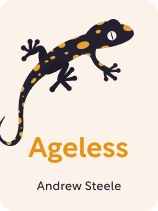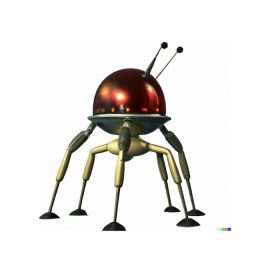
What is aging in humans? What are common myths about aging?
Though we all know on a basic level what “aging” is, scientists often use common terms differently than the general public. In Ageless, Andrew Steele defines aging and explores common myths that prevent laypeople and scientists alike from understanding aging as a process we can modify.
Let’s look at the definition of aging, according to Steele and other experts.
How Should We Think About Aging?
What is aging in humans? Steele uses the word “aging” to refer to the process that causes our health to decline—and our likelihood of getting sick or dying to grow—as we get older. A key insight is that the diseases that kill us occur because of the aging process. Steele explains that age is the most significant risk factor for heart disease, stroke, dementia, and cancer, which we often think of as causes of death. He contends that because aging sets these diseases into motion, aging itself is the cause of approximately two-thirds of deaths globally.
(Shortform note: Scientists haven’t quite agreed on a definition of aging—or on whether there’s a single phenomenon that the word describes. But they do generally agree on the features of aging: Like Steele, most define aging as a process through which we become more vulnerable to disease, injury, and death over time. This process has intrinsic and extrinsic causes, both from inside our bodies and in our environments.)
Steele explains that even if we don’t develop heart disease or cancer as we get older, none of us are immune to the effects of aging. As we age, we experience more minor physical and mental changes that might not be considered diseases, but still reduce our quality of life: We get less physically fit, our health worsens, and our thinking and memory decline. Steele sees aging as a problem of human suffering—suffering that doesn’t have to be our fate.
| Should We Accept Aging as a Cause of Death—and Suffering? Some experts agree with Steele that we can think of aging as a cause of death—in Lifespan, biologist David Sinclair characterizes old age as a deadly disease, one that’s treatable like any other disease. Conversely, other experts contend aging isn’t a disease but instead is a “normal process” we’ll all go through, or they consider aging a cause of disease, but not a disease itself. Whether or not aging is a cause of death or disease, researchers agree that aging people suffer as they get sick, lose loved ones, become isolated, or feel a lack of control. Some say that the Buddhist understanding of suffering might help. As the Dalai Lama writes in The Art of Happiness, Buddhists believe that everyone suffers and we have to accept suffering. A similar message comes from Being Mortal, where surgeon Atul Gawande writes that seeing age-related diseases as a problem to be solved prevents us from talking honestly about what matters most to us as we get older. Gawande contends that if we see the deterioration of the body as a natural process, we can better support each other in facing the challenges of aging. |
What Do We Get Wrong About Aging?
Steele writes that a few mistakes in our thinking about aging prevent us from understanding how the process works—or from realizing how much we can change the relationship between age and health. The first of these mistakes is to think that aging is inevitable. Steele argues that we don’t have to age as we currently do. He explains that by studying the biological causes behind age-related diseases, scientists can learn to slow, reverse, or prevent them altogether.
The second mistake—which follows from the idea that scientists can study the biological causes of age-related diseases—is that we fixate on diseases rather than on the aging process itself. Steele writes that we think of the diseases associated with age as separate processes, but they’re actually set into motion by physiological changes that affect our entire body. (Shortform note: Two Harvard Medical School professors agree with Steele and contend that logically, there must be a fundamental feature that drives the processes observed with aging. They argue that scientists should be studying this underlying force that causes aging.)
Finally, a third mistake is to think that the goal of curing aging is to live forever. Steele writes that the goal isn’t to become immortal but to become “ageless” by living healthier lives to the point that our risk of death won’t be correlated with our age anymore.
| We Can’t Live Forever—or Can We? Steele explains that most scientists aren’t trying to enable humans to live forever. Instead, they want to extend what researchers call our “healthspan”: the years we live in good health. Healthspan is a new enough idea that scientists haven’t yet figured out how to measure it. Some experts say a flaw with the concept is that health isn’t a binary condition, with a clear line dividing good health from bad health. Our perception of our health is also subjective, which complicates defining when we’ve reached the end of our healthspan. Though most scientists don’t think we should attempt to live forever, a few researchers think it’s worth a try. They fall into two groups: those who think we could live forever in our natural bodies and those who envision merging our biology with mechanical bodies or the cloud. In The Singularity Is Near, computer scientist Ray Kurzweil writes that treatments that target flaws in people’s genetics, replace damaged genes, and grow new organs could enable us to chase immortality while leaving some of the limitations of the body behind. |
What Would It Mean to Cure Aging?
The idea of increasing human lifespans is complicated not only on a scientific level but also on an ethical level. Steele admits that it quickly gets tangled up with questions about population growth, social inequality, and the environment. Yet he argues that the benefits of eliminating the suffering of aging outweigh the costs, thus making it important to increase awareness of scientific discoveries, make regulatory changes that shorten the path from lab to clinic, and allocate more funding to aging research.
| What Are the Ethical Implications of a Cure for Aging? Annie Murphy Paul, author of The Extended Mind, contends that Steele doesn’t address the ethical implications of a cure for aging, which would disrupt our society and change how we make meaning of our lives. Other experts say that extending the human lifespan would have social, political, and economic implications and would raise questions about environmental sustainability. Additionally, some observers warn that uneven access to anti-aging treatments would raise thorny moral questions by opening a new divide between people wealthy enough to purchase life-extending treatments and people without the means to do so. Steele’s call to shorten the regulatory process for anti-aging treatments also has ethical implications, which go unexplored in the book. Critics say that while the FDA’s drug approval process has sped up, it now relies on weaker science to determine if drugs are safe or effective. Advocates want a faster regulatory process, as it currently takes 12 years for a drug to go from testing to FDA approval. But that would require major steps like classifying aging as a disease, deciding how to measure it, and weighing tradeoffs between speed and safety. |

———End of Preview———
Like what you just read? Read the rest of the world's best book summary and analysis of Andrew Steele's "Ageless" at Shortform.
Here's what you'll find in our full Ageless summary:
- The processes that make us grow sicker and slower as we age
- How future treatments may treat—and even cure—aging
- Proven steps you can take right now to slow your aging process






